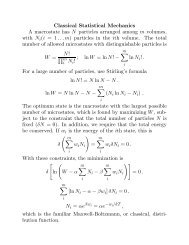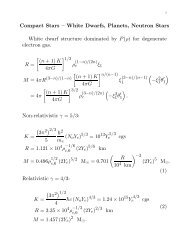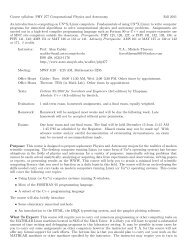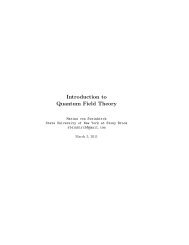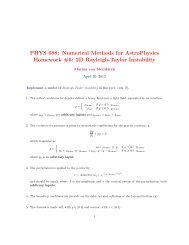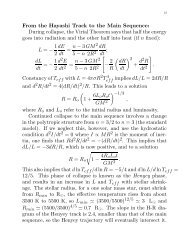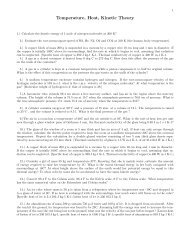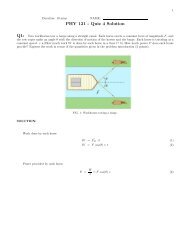printable - Stony Brook Astronomy - Stony Brook University
printable - Stony Brook Astronomy - Stony Brook University
printable - Stony Brook Astronomy - Stony Brook University
Create successful ePaper yourself
Turn your PDF publications into a flip-book with our unique Google optimized e-Paper software.
2.2 Bachelor of Science in Physics<br />
For the Bachelor of Science degree in Physics, the official requirements are listed in the undergraduate bulletin 2 , but we<br />
summarize them here for informational purposes. Completion of the major requires approximately 49 credits in Physics and<br />
physics related courses, and 14 credits in Mathematics. Note that completion of the Diversified Education Curriculum or DEC<br />
requirements other than C (Mathematical and Statistical Reasoning) and E (Natural Science) requires about 36 credits. Students<br />
thus have 20 credits or more to “play with” beyond completing university and Physics B.S. requirements if students take the<br />
minimum of 120 credits for their degree. Up to three courses at the 100 – 200 level passed with a C- may be applied to the<br />
major; all others including upper division courses must be passed with a letter grade of C or higher.<br />
The following Physics courses are required for the Physics B.S. degree:<br />
• PHY 131, 132 Classical Physics I, II (note that the PHY 125, 126, 127 sequence, or the 141, 142 sequence, are also<br />
acceptable).<br />
• PHY 251/252 Modern Physics plus laboratory<br />
• PHY 277 (AST 277) Computation for Physics and <strong>Astronomy</strong><br />
• PHY 300 Waves and Optics<br />
• PHY 301 Electromagnetic Theory I<br />
• PHY 303 Mechanics<br />
• PHY 306 Thermodynamics, Kinetic Theory, and Statistical Mechanics<br />
• PHY 308 Quantum Physics<br />
• PHY 335 Electronics and Instrumentation Laboratory<br />
• PHY 445 Senior Laboratory I<br />
At least four courses numbered 300 or higher submitted for the major must be taken at <strong>Stony</strong> <strong>Brook</strong>.<br />
The following Mathematics courses are required for the Physics B.S. degree:<br />
• One of the following sequences: MAT 131, 132 (Calculus I, II) or MAT 141, 142 (Honors Calculus I, II) or MAT 125,<br />
126, 127 (Calculus A, B, C)<br />
• One of the following: MAT 205 (Calculus III), or MAT 203 (Calculus III with Applications), or AMS 261 (Applied<br />
Calculus III). Note that MAT 205 has MAT 211 or AMS 210 (linear algebra) as a pre-requisite, but this is a course<br />
strongly recommended for research-oriented physics majors anyway.<br />
• One of the following: MAT 305 (Calculus IV), or MAT 303 (Calculus IV with Applications), or AMS 361 (Applied<br />
Calculus IV: Differential Equations)<br />
Equivalency for MAT courses achieved on the Mathematics Placement Examination is accepted as fulfillment of the corresponding<br />
requirements without the necessity of substituting other credits. Students must also complete twelve credits of<br />
approved physics-related courses (see Sec. 2.10) that complement a physics major’s education.<br />
2.2.1 Upper-Division Writing Requirement<br />
Students are certified as satisfying their Upper-Division Writing Requirement by completing a writing project within their major.<br />
Whether one works in research or in industry, clear and effective written communication is incredibly important. Physicists and<br />
Astronomers are called upon to effectively and succinctly communicate their research results in journal publications, and also<br />
to convey the importance of their research goals and their plan for achieving them in funding applications (whether for Federal<br />
or private research funds, or for internal R&D funds in industry). Students in the senior laboratory course will gain experience<br />
in standard technical communication of the sort used in research papers and posters, and this will be reflected in their obtaining<br />
a passing grade for the course. To meet the Upper-Division Writing Requirement for the B.S. in Physics, something beyond<br />
this terse form of writing of experimental results is required. Examples of how this can be achieved include:<br />
2 http://www.stonybrook.edu/ugrdbulletin/current/pdfs/phyM.pdf<br />
5



